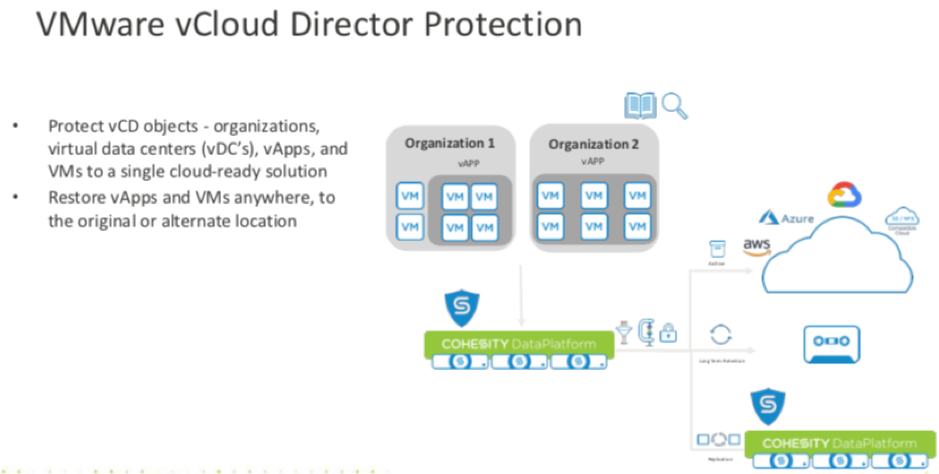In this second part of the vRetreat Cohesity blog I will be updating you on the “Simple at Scale” components that Cohesity have been investing into, as well as the integrations and analytics tooling now available within the platform.
SIMPLE AT SCALE
The simple at scale breakdown from Cohesity is made up of Multi-Tenancy, Multi-Cluster management, smart assist and API integrations for automation aimed at their partnered service providers.
Analysts have outlined that a broad adoption of service provider delivered cloud offerings providing secondary storage as a service options to their customers. IDC provided the following overview:

From my experiences working for global reseller & service provider is that there is more appetite for organisations to take an “easy” consumable service that is predictable for growth commercially, whilst allowing the service provider to manage the technical complexity… especially around secondary storage services such as test/dev and backup. I wouldn’t say I totally agree with the IDC comments above, as a lot of organisations are still finding their way with their cloud strategies and journeys.
Cohesity are looking to be a comprehensive solution for service providers by providing the high-level capabilities below:

The key here is the broad options service providers have to implement and build on the platform to deliver unique offerings, covering various clouds and self service access. Cohesity want to be the one stop shop for service provider secondary storage offerings providing:
- Backup as a service
- DRaaS
- Filer & object store as a service
- Cloud native back up
- Test/dev aaS
- Analytics as a service (generating value from untapped data)
For service providers the Cohesity platform has the capability to provide secure isolation for multi-tenant deployments by utilising management isolation capability as well as infrastructure isolation. Infrastructure isolation is delivered through each client on the platform having their own private encryption key and logical storage pool with crypto-erase, with logical isolation through VLAN configurations.
At the heart of most service provider platforms there is a requirement to provide an element of self service capability and automation to drive cost efficient service pricing. (less reliance on human contact for some tasks). Cohesity has invested in integrations with VMware, ServiceNow etc. through the Cohesity portal and custom APIs available.

To touch on one area of integration would be VMware vCloud Director (vCD). By integrating vCD and Cohesity you can look to provide integrated self-service and IaaS with data protection built in. the feature and benefits of this can be found below:
| Features | Benefits |
| Full self-service backup and restore from within vCD UI and REST API | Simple, easy-to-use UI and unified customer experience |
| Automate protection of vDC, vApp and VM | Seamless, automated protection for enterprise data |
| Instantly restore vApp, VMs or files to original or alternate location | |
| Flexible chargeback reporting |

One of the key reporting elements for service providers is how you look to chargeback and track consumption on the platform(s). Cohesity has built in chargeback showing each tenant consumption.

The roadmap for Cohesity shared on the day can be seen below (hopefully this wasn’t NDA as it doesn’t mention it anywhere)

COHESITY HELIOS
Cohesity Helios provides a single view and global management of all Cohesity secondary data and applications wherever they reside on-premises, cloud, and edge. Cohesity Helios utilizes machine learning algorithms to proactively assess IT needs and automate infrastructure resources where needed. The Helios platform has been built using guiding principles of “Simple, smart, proactive” allowing for ease of management, troubleshooting and third
party integration.

To pick on smart assist, I believe this is where a lot of the power can be derived within the platform allowing for 3month data projections with alerting capabilities, alerting based on potential failures 60 days ahead of failure and visual cues on major changes / events allowing for faster troubleshooting and RCA.
Cohesity Helios empowers IT professionals with machine-driven intelligence to detect and report any anomalies. A powerful use case for this is the quick detection and response to potential ransomware attacks. Based on data outlined by Cohesity 40% of organizations have
experienced a Ransomware attack, and 35% of attacks have been resolved through paid ransoms.

PREVENT:

DETECT:

RESPOND:

A video on how Helios can assist with ransomware protection can be found below:
READY TO USE INTEGRATIONS
Cohesity has been working with the community and internal teams to provide their customers with ready to use automation integration capabilities spanning:
- PowerShell
- Ansible
- vRealize Automation
- ServiceNow
The features and benefits of each of these can be found below.
POWERSHELL:
Features:
- ~80 Cmdlets for common tasks
- Supports Windows, MacOS and Linux
- Easy-to-install using PowerShell Gallery
Benefits:
- Automate repetitive tasks and save a lot of hours
- Fits nicely into your existing automation
- Offer self-service to application owners
Find out more at: https://cohesity.github.io/cohesity-powershell-module
ANSIBLE:
- Hosted on GitHub:
- Role includes these Ansible tasks:
- Install/Uninstall Cohesity Agent on Windows, Linux
- Register/Unregister Protection Sources – VMware, Physical, NAS
- Create Protection Jobs – VMware, Physical, NAS
- On-demand backup
- Recover VMs or Files
- Example Ansible playbooks: https://cohesity.github.io/cohesity-ansible-role/#/
VREALIZE PLUGIN:
- Available on VMware Solution Exchange
- Available workflows for Self-Service
- Add VM to a protection job (as it gets provisioned or after-the-fact)
- Remove VM from protection job (as it gets destroyed or after-the-fact)
- On-demand backup
- Recover VM or Files
- Clone VM
- Workflows available as Self-Service blueprints in vRA catalog
SERVICE NOW:
- Available on ServiceNow Store
- Available self-service features
- Add VM to a protection job
- Remove VM from protection job
- Recover VM or Files
- Clone VM
- Approval-based flows
- Can also create ServiceNow tickets based on Cohesity alerts using inbound email actions
